| Top Ten NYC Architecture | top ten New York Synagogues | |||||||||||||
| For a more complete list, see Synagogues | ||||||||||||||
| 1 | Temple Emanu-El | |||||||||||||
 |
Founded 1845; first Reform congregation in New York City; consolidated with Temple Beth-El in 1927; present structure completed in 1929 and dedicated in 1930; largest Jewish house of worship in the world; Goldsmith Religious School Building dedicated in 1963 The facade of the building features an arch with symbols representing the twelve tribes of Israel, flanked by two very 1920s lions resting on semi-engaged columns. At the top, the arch wraps around a magnificent wheel-shaped window which has a traditional Magen David (six-pointed star) embedded in the center. Three sets of beautiful bronze doors, which also bear symbols of the twelve tribes, serve as the entrance. |
|||||||||||||
| 2 | Central Synagogue | |||||||||||||
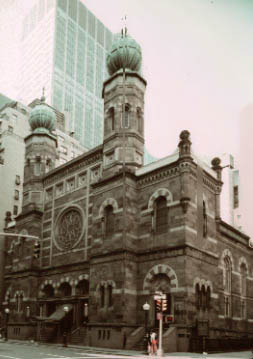 |
Central Synagogue at the corner of Lexington and 55th is the oldest synagogue in continual usage in New York City. Designed by Henry Fernbach of Germany, the design is loosely called "Moorish-Islamic Revival". The synagogue was built by Congregation Ahawath Chesed, a German Reform congregation meeting under that name on Ludlow street from 1846. The Exterior: is dominated by two octagonal towers rising 122 feet. They are meant to be reminiscences of Solomon's Temple. The towers are topped onion-shaped, green copper domes. There is one large rose window accompanied by many smaller arched windows. The Interior: has beautifully stenciled designs of red, blue, and ochre. Cast iron columns separate the inside into three sections. There is also colorful plates published by the English designer and colorist, Owen Jones. |
|||||||||||||
| 3 | Park East Synagogue | |||||||||||||
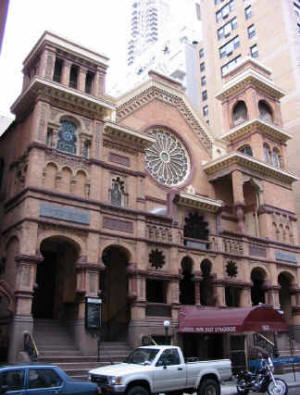 |
Park East Synagogue is located on the Upper East Side of Manhattan, in New York. It was founded in 1890 as Congregation Zichron Ephraim. Since 1962, it has been led by its spiritual leader Rabbi Arthur Schneier. The current Assistant Rabbi (since August 2006), Rabbi Evan Hoffman delivers a Wednesday evening Bible class which fills the hall to capacity. In 1976, Rabbi Schneier founded the Park East Day School, which now educates children from early childhood through eighth grade. The building is listed on the National Register of Historic Places. |
|||||||||||||
| 4 | Civic Center Synagogue | |||||||||||||
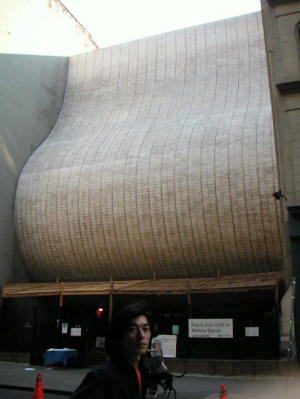 |
Baruchim Ha Ba'im. Also known as the Synagogue for the Arts, the Civic Center Synagogue is a spiritual, cultural, and communal center of traditional Judaism, located in downtown Manhattan's Tribeca neighborhood. The synagogue was founded some sixty years ago, as Congregation Shaare Zedek, by businessmen working in the fabric trade, as well as civil servants who needed a place to pray during working hours. Today, with Tribeca, Soho, Battery Park City, and Wall Street home to a growing number of Jewish families and individuals, Civic Center is a full-service synagogue. Designed by William H. Breger, the award-winning contemporary building features a distinctive flame-shaped, sky-lit sanctuary, outdoor sculpture plaza, a large gallery for events, and a well-equipped kosher kitchen. Rabbi Jonathan Glass will celebrate his tenth anniversary with the synagogue next year. The Hebrew School, for children ages four through thirteen, is also a decade old. The CCS Art Gallery, which sponsors exhibitions every six weeks throughout the year, is nearing its fifth anniversary. |
|||||||||||||
| 5 | Congregation K'Hal Adath Jeshurun | |||||||||||||
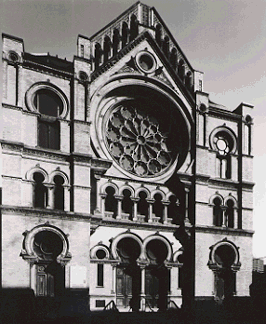 |
When completed in 1887, the Eldridge Street Synagogue was "reviewed" in the local press. Writers marveled at the imposing Moorish-style building, with its 70-foot-high vaulted ceiling, magnificent stained glass rose windows, elaborate brass fixtures and hand-stenciled walls. Thousands participated in religious services in the building's heyday -- so many that, on High Holidays, police were stationed in the street to control the crowds. The diverse membership of K'hal Adath Jeshurun exemplified the immigrant spirit, the resilience, artistry and accomplishments of first generation Americans. The artists Ben Shahn and Max Gropper, the performers Eddie Cantor, Paul Muni and Edward G. Robinson, and scientist Jonas Salk were among those who attended Eldridge Street in the early decades of this century. For fifty years, the Synagogue flourished. Then membership began to dwindle as immigration laws changed, members moved to other parts of New York City and America, and the Great Depression affected the congregants' fortunes. The exquisite main sanctuary was used less and less during the 1930s, and was abandoned some time in the mid-1950s. In the late 1970s, when the Synagogue building was in serious jeopardy, it came to the attention of an NYU professor who led walking tours of the neighborhood. He rallied together a volunteer organization, the Friends of the Eldridge Street Synagogue, to rescue the historic Synagogue. This dedicated group recognized the building's architectural distinction and its significance for American Jews. |
|||||||||||||
| 6 | Bialystoker Synagogue | |||||||||||||
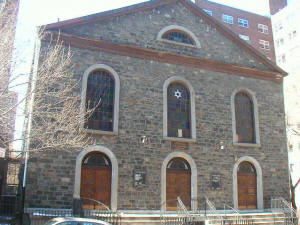 |
The Bialystoker Synagogue was first organized in 1865 on Manhattan's Lower East Side as the Chevra Anshei Chesed of Bialystok, founded by a group of Jews who came from town of Białystok in Poland. The congregation was begun in a building on Hester Street, then it later moved to Orchard Street, and ultimately to its present location 7-11 Bialystoker Place on the Lower East Side. In order to accommodate the influx of new immigrants from that area of Poland, in 1905 the congregation merged with congregation Hadas Yeshuan, also from Bialystok, and formed the Bait Ha'Knesset Anshi Bialystok (The Bialystoker Synagogue). The newly formed congregation then purchased and moved into The Willett Street Methodist Episcopal Church at 7 Willet Street (now 7-11 Willet Street, later renamed Bialystoker Place). During the Great Depression, a decision was made to beautify the main sanctuary, to provide a sense of hope and inspiration to the community. |
|||||||||||||
| 7 | Former First Warsaw Congregation | |||||||||||||
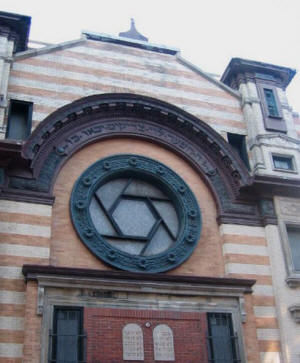 |
This former synagogue was built in 1903 for Jews from the town of Iasi, Romania; the architect was Emery Roth, who went on to build fancy apartment buildings like the San Remo and the Ritz Tower. Later it was the Erste Warshawer (First Warsaw) Synagogue, for a Polish congregation that organized in 1886. The interior featured two galleries in the sanctuary and large bronze chandeliers. Since 1973 it's been artists' studios and residences. |
|||||||||||||
| 8 | Congregation Shaarai Shomoyim (Demolished) | |||||||||||||
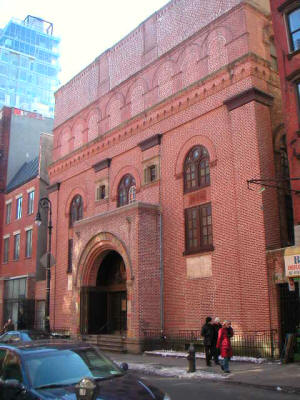 |
This 2,000-seat sanctuary was originally built around 1857 as the German Evangelical Church. Designed to convert Jews, it was bought in 1864 by Shaaray Hashomayim, New York's oldest Orthodox German-Jewish congregation. It reverted to a church in 1890, when a Methodist mission society moved the Allen Street Memorial Church here. Finally the current congregation bought it in 1902. Recognized as a center for cantorial music, the synagogue was known as "the Cantor’s Carnegie Hall." It's been a synagogue ever since, though no longer primarily Romanian. Led by Rabbi Jacob Spiegel and offering daily services, the present congregation draws its members from the local Jewish community of residents and merchants. In January of 2006, the roof of the synagogue caved in, severely damaging the main sanctuary. No one was injured, since services had long since been held in the basement. Because the synagogue had never been registered as a historic landmark, it was thereafter demolished in March 2006. |
|||||||||||||
| 9 | Temple Emanu-El (Demolished) | |||||||||||||
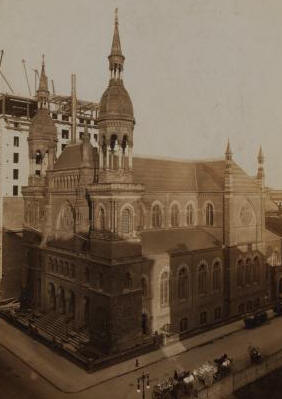 |
Temple Emanu-El was designed by Leopold Eidlitz, architect of showman P.T. Barnum's Connecticut home "Iranistan." Dedicated in 1868, this Gothic and Moorish structure was decorated in bright tones of yellow brownstone with alternating red and black roof tiles. Only preserved in postcards and illustrations, the synagogue at 5th Street and 43rd Avenue was leveled in the early twentieth century. |
|||||||||||||
| 10 | Temple Beth-El (Demolished) | |||||||||||||
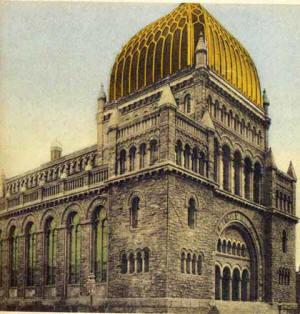 |
Historic Temple Beth-El at Fifth Avenue and Seventy-sixth Street is being demolished to make room for an apartment house. The Romanesque edifice, once regarded as one of the finest synagogues in this country, now resembles a bombed-out building. Its floors are covered with rubble; only the slender steel frame remains of the roof. The building, little used since the eve of Yom Kippur (the day of Atonement) of 1929, will be leveled in about six weeks. Its congregation merged with congregation Emanu-El in 1927 and both worshipped in the old synagogue until the new temple Emanu-el at Fifth Avenue and Sixty-fifth Street was dedicated on January 10, 1930. The Rev. Dr. Samuel Schulman, last rabbi of Temple Beth-El, recalled yesterday his last service there in 1929. "I remember on that day that I quoted from the legend in the Talmud that God was weeping over the ruins of His temple," he said. "So I, too, felt, deep in my heart." |
|||||||||||||